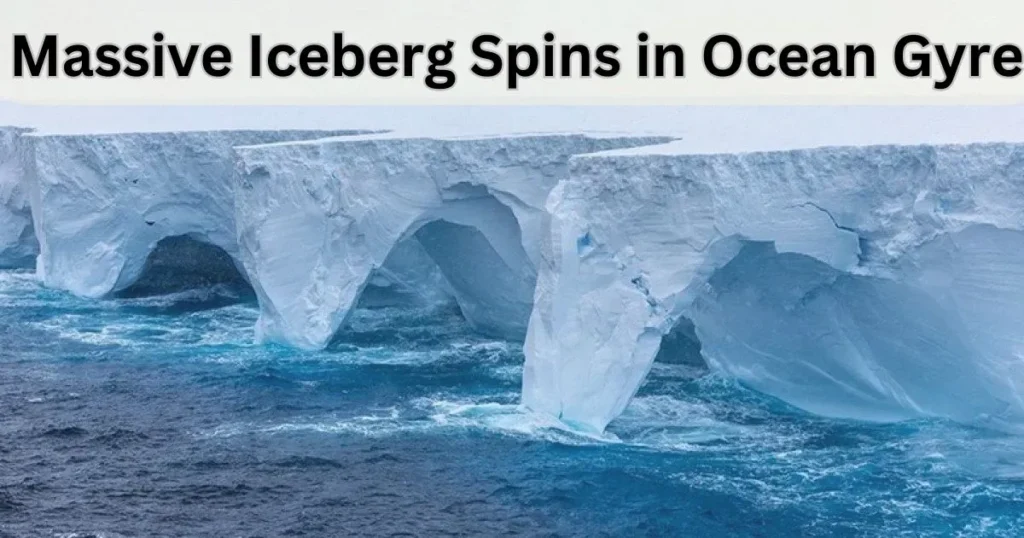The massive iceberg, the world’s largest, trapped in a spinning ocean gyre, illustrates how ocean currents dramatically influence the movement and positioning of colossal ice formations. This dynamic interaction highlights the fluidity of polar ice landscapes and how environmental forces continually reshape these immense structures.
What occurs at the same time as the sector’s largest iceberg gets stuck in an ocean entice? Discover the dramatic spin in the massive iceberg.
The international’s massive iceberg, known as A-76, has ended up ensnared in an ocean entice, causing it to spin inside a powerful gyre. This awesome occasion illustrates the impact of ocean currents on massive ice formations.
Discovery of the massive iceberg: A-76
A-76, the world’s largest iceberg, became positioned in May 2021 even as it calved from the Ronne Ice Shelf in Antarctica. Measuring approximately 4,320 rectangular kilometers, it quickly received attention for its sheer length and the capacity implications of its flow via the Southern Ocean.
This large iceberg, comparable in duration to the island of Majorca, underscores the dramatic sports taking place in polar areas and has grown to be a focal point for scientists and environmentalists alike, who’re eager to look at its actions and the factors that brought about its formation.

Ocean gyres are massive structures of round currents fashioned via global wind styles and forces created through the Earth’s rotation. These gyres, observed in each hemisphere, are crucial in regulating weather and oceanic ecosystems.
In the context of icebergs like A-76, gyres play an extensive characteristic in their motion and eventual future. Trapped in the ones effective, circulating waters, icebergs may be carried notable distances from their factor of beginning, influencing now not pleasant their trajectory however moreover their rate of melting and interplay with extraordinary oceanic features.
Impact of Ocean Currents on Icebergs
Ocean currents are important in determining the path and conduct of icebergs. The powerful currents can trap the ones huge ice formations, inflicting them to spin and waft in tactics which can be each predictable and erratic. A-76’s cutting-edge capture 22 state of affairs in an ocean lure highlights this dynamic interplay.
The interplay of some of the iceberg and the ocean currents can result in some effects, which embody the functionality for the iceberg to interrupt aside, adjust its path, or become lodged in the route of the seafloor, every state of affairs wearing great implications for the encompassing surroundings.
The Journey of the World’s Largest Iceberg
Since its separation from the Ronne Ice Shelf, A-seventy six has launched into a captivating adventure. It has traveled via the Weddell Sea, turning into an ocean gyre. Its improvement and movements are intently monitored through scientists using satellite tv for laptop television for computer imagery to better understand the conduct of such wonderful ice hundreds.
These observations provide important records on how massive icebergs have interaction with ocean currents and the physical procedures that govern their motion, presenting treasured insights into the wider dynamics of polar areas.

Environmental Implications
The motion and eventual melting of A-seventy six have extensive environmental implications. As it melts, it’s going to make contributions to freshwater to the ocean, potentially impacting sea tiers and nearby ecosystems. The influx of this sort of huge amount of freshwater can disrupt oceanic salinity, affecting marine life and ocean float styles.
Additionally, the iceberg’s journey can offer insights into the wider effects of climate change on polar ice. Understanding how large ice formations behave and interact with their environment allows scientists to look forward to future changes and prepare for capability impacts on global sea levels and weather patterns.
Tracking and Monitoring A-76
Scientists use superior satellite technology to sing and show the A-76. This era lets in for unique measurements of its size, position, and motion, offering precious information for researchers analyzing the outcomes of weather trade and the behavior of massive icebergs in ocean currents.
The targeted monitoring of A-seventy-six allows scientists to version its future trajectory, are looking for potential damage-up activities, and verify the wider implications of its journey. This non-stop monitoring is critical for advancing our expertise of polar strategies and improving predictive fashions of iceberg conduct.
Future Predictions for A-seventy six
Predicting the destiny of A-76 includes thinking about elements together with ocean currents, temperature, and the iceberg’s structural integrity. While it’s predicted to keep its journey, ultimately breaking aside and melting, the exact timeline and impacts of those sports activities live as subjects of ongoing research.
Scientists are in particular interested in how A-seventy-six may additionally have interplay with warmer waters and whether or not it’s going to pose any risks to transport routes or coastal regions. The facts collected from A-seventy sixes adventure will beautify our functionality to count on and mitigate the effects of future huge iceberg calving activities.

The Role of Climate Change in Iceberg Movements
Climate exchange plays a crucial position within the frequency and conduct of iceberg calving activities. Rising international temperatures make a contribution to the destabilization of ice cabinets, primary to the formation of huge icebergs like A-76. The elevated calving of icebergs is an easy indicator of the warming climate and its effects on polar areas.
Understanding those strategies is essential for predicting destiny adjustments in polar regions and their worldwide influences. By reading sports activities like the calving of A-seventy six, scientists can better recognize the connections amongst climate exchange, ice shelf balance, and the motion of icebergs, informing techniques to deal with and adapt to those massive environmental modifications.
FAQ’S
What is the area’s massive iceberg?
The world’s massive iceberg, named A-seventy six, measures about 4,320 rectangular kilometers and calved from Antarctica’s Ronne Ice Shelf in May 2021.
Why is A-seventy six spinning in the ocean?
A-seventy-six is caught in an ocean gyre, a large tool of round currents, inflicting it to spin internal the ones effective waters.
How are scientists tracking A-76?
Scientists use advanced satellite tv for laptop generation to expose A-seventy sixes size, function, and movement, supplying precious facts on its adventure.
What are the environmental impacts of A-seventy six?
As A-76 melts, it’s going to make contributions to freshwater to the ocean, in all likelihood affecting sea stages, ocean salinity, and close ecosystems.
How does weather trade have an effect on iceberg calving?
Rising international temperatures destabilize ice shelves, foremost to more common and big iceberg calving events, together with the formation of A-76.
Conclusion
The massive iceberg spinning of the area’s biggest iceberg, A-seventy-six, in an ocean entice highlights the complex interactions amongst huge ice formations and ocean currents. Its adventure gives crucial insights into the consequences of weather change on polar ice dynamics and the wider environmental effect of such tremendous icebergs.
You can read this post

